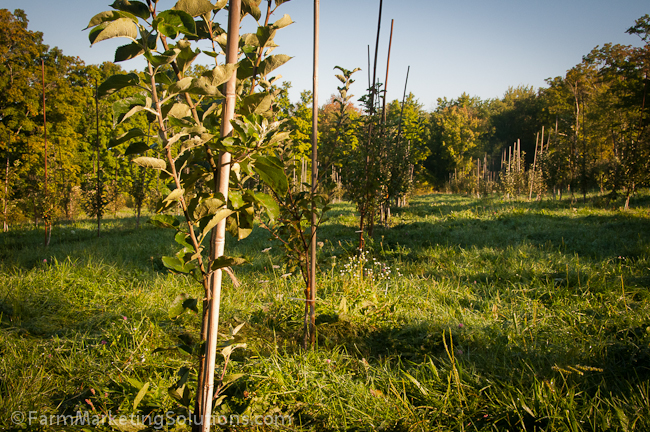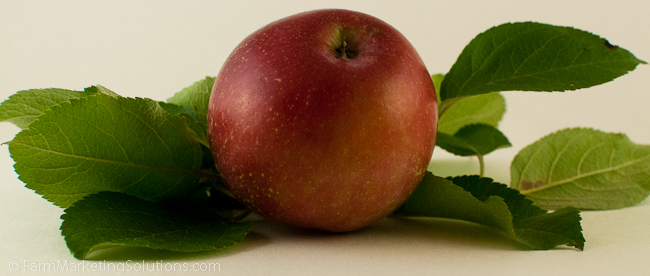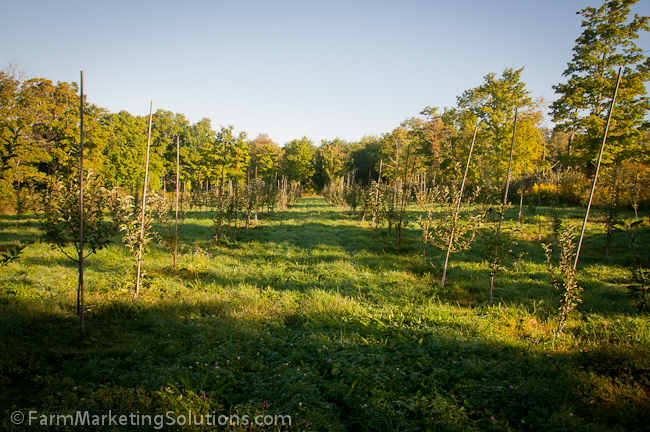2015 Young Orchard Yearly Budget
/http://youtu.be/dZrQ_RGDNSs While the orcahrd is not a money maker on farm at the moment it is an important part of our narrative. As part of the farm we work very closely with a distillery who produces apple-based spirits like Apple Brandy, Hard Cider, and Bourbon. We invested in putting in an apple orchard for a number of reasons.
- Our orchard will help provide rare apples that are good for distilling that the current growers are having trouble supplying because of the increased demand in the market.
- It adds marketing juice to the distillery to esentially have their own orchard where they source locally from.
- It further diversifies our farm so that down the road we have several operations to keep our income diverse.
- The farm can use the apples for cider, you-pick, apple pies, etc... if we so choose to go down that road.
So while there is no return this year as far as apple yeild, that has been planned for in the budget. The distillery helps cover part of the cost, the other operations on farm help cover part of the cost. It's a tricky endevor, but also quite exciting. Personally I really enjoy watching the trees grow up.
To download the excel file:
If you would like the excel file shown in this video then you have the option of scrolling to the bottom of the page to sign up for the Farm Marketing Solutions Email List. When you enter in your information then I will send you a free copy of the excel sheet for you to do as you wish.
As part of the email list I will automatically send you the future budget sheets so you only have to sign up once. You will also receive exclusive content, news from FMS, and a little bit of hilarity in your day.

Starting an Apple Orchard
Establishing an orchard of any kind is a process that takes years. The first year you plant trees which look like weak little sticks that you hope survive. Over time with love and attention you eventually get trees that bear beautiful fruit that you can eat raw or turn into delicious apple pies or distill into apple based spirits. Here's the timeline for our orchard as I see it:
- Spring 2013: Apple whips were planted on a hillside with good drainage, plenty of sun, some nearby hedgerows to help buffer winds but plenty of air circulation still the same.
- 2014: Trees were pruned in the winter after having a year to grow. We are pruning them to have a central leader and to take on the shape (kind of) like a Christmas Tree.
- 2015: They will get another winter pruning as they will get each year further shaping the tree. Still no fruit because we pinch all the buds back to encourage tree growth and not fruiting.
- 2016: Still no fruit as we are working on developing strong trees.
- 2017: Hope to see our first harvest this year, but who knows? Maybe that's too soon. Maybe I waited too long. I hear both stories at this point. If you have advice please leave it in the comments below.
Now, I'm really new to starting and maintaining an orchard. I will tell you one thing, there are 100 conflicting ways to do it! We are attempting to do it organically which I am also told is impossible. More on that in just a second.
Wait, you keep talking about a Distillery

I took that picture of the apple. Fun product shot right? Anyways, yes, we have a distillery. Camps Road Farm, the farm that I manage is part of "The Food Cycle LLC". Under the umbrella of the LLC operates three separate but interlinked and interdependent businesses. There is the farm, a craft brewery, and a distillery. The Brewery iswhere the hops from the farm go and in turn we get their spent grains to do with as we please. The distillery is where our apples go and we get the spent apple mash.
The distillery is Neversink Spirits,and I'll let them tell you their version of the story:
Neversink Spirits was founded by two long-time friends with a passion for spirits, wine, food, and nature. After years of tasting, tinkering, sipping and planning, Noah Braunstein and Yoni Rabino found a project in which their passions could be realized – and Neversink Spirits was born. Making spirits is their calling, apples their muse, and they finally found the vehicle in which to share their vision with their fans.
A spirit’s quality can only be as high as the ingredients from which it’s made. When they formed a team with Camps Road Farm and Kent Falls Brewery to form a local collective known as “The Food Cycle,” they knew they had found a way to make their spirits truly unique.
Working together, the partners carefully developed a growing plan for the farm, cultivating ingredients specifically designed to make exceptional spirits and beers. Being able to verify the supply chain’s provenance allows Neversink Spirits to make spirits of the highest quality, while minimizing the footprint on our planet. Waste from the brewing and distilling processes is recycled back on the farm as compost and animal feed, increasing the productivity of the farm and closing the sustainability loop.
Apples are the cornerstone of Neversink Spirits’ production. In 2012, through a grassroots effort from volunteers and friends, we planted over 350 apple trees on Camps Road Farm. Spirits produced from the over 15 varieties of apples, all difficult to obtain heritage varietals that produce excellent cider and brandies, will excite the palate with new ways to experience of America’s favorite fruit. We are passionate about apples and want to share that passion with our fans.
Based in Port Chester, NY, Neversink Spirits is currently setting up its facility and refining recipes. The opening is being planned for the fall of 2014 and Neversink Spirits will start releasing its line of fine spirits. Look out for an apple brandy, an apple and herb eau-de-vie, a whiskey made with sustainably produced New York grains, and a surprise collaboration with the brewery!
We love spirits. We love apples. We love our planet. And, we love you.
How we grow our apples:
We are attempting to grow our trees organically. We are following the organic standards on farm with everything we do potentially working toward actual certification. At the moment it doesn't make sense for use to certify, I also think we're not yet eligible.
I have started a YouTube playlist with videos about what we have done so far in our orchard. Here's that playlist to show you more specifically how we have started our orchard.
http://youtu.be/soRIMMY4968?list=PL-O8flggtY_vpymji6Fgy5FI65MUCegaM
If you have any further questions please leave themin the comments section below and I will do my best to help you out.

Other apple orchard information:
There have been three great places where I am getting a lot of my orcahrd information. The first is my neighbor Averill Orchards who has been in the apple business for I think a million years, or at least the family has. The youngest generation to pickof the pruning sheers is about my age and I have to admit, they're awesome. I constantly badger them with questions about how they start new trees and how they maintain a healthy orchard. They are low-spray, not organic, but that doesn't stop them from being a weatlth of information.
This is a good point to bring up that the best information that you will get is not going to come from a book, but from another local grower. They know your climate, they know the minutia, they have the examples on their farm to show you, and they probably have been doing it longer. Do not be afraid to reach out and ask questions. Just a word of advice, do more listening than talking, take notes, and bring them a gift for their time. They're as busy if not more busy than you.
The second place has been my local agricultural extension agents. Same thing as above, but they are designed to answer your questions. Make use of your extension agents, they're great, they're nice, and they know where to find the answers you are looking for.
The last place is indeed a book. "The Apple Grower" by Michael Pillips. I have learned a lot from this book. Not all of it I have taken action on and there's even things I do a little different. It's all about learning as much as you can and adapting it to your situation. Here's a link:
A favor to ask of you orchardists out there:
What is my budget missing? I don't pretend to have all the answers for everything farming. I am only a handfull of years in and I am learning as I go. If you have more knowledge or something to share I want to invite you to comment in the comments section below and I will add it into the blog post here and give you credit. I am constantly lookingto improve all areas of the farm and I know this is an area that I could stand to get some growth.
